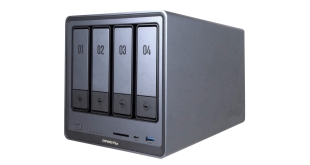Researchers have created a functional integrated circuit smaller than a grain of salt. This circuit is a broadband frequency mixer which according to IBM researcher Yu Ming Lin is “one of the most fundamental and important circuits in essentially all wireless communication devices and equipment.”
The new circuit design is made of graphene, a crystalline material which is made with a single layer of carbon atoms. Graphene is an exciting material for researchers because it can be stretched like rubber and is an excellent conductor of heat and electricity. When compared with silicon, a transistor made from graphene can be less expensive, demand less energy and reduce size demands, ideal for portable devices.

Graphene also has potential for other products, such as lighter body armor and even touch screen displays. Lin added “This is a circuit component that has a real function, a practical use in a real application, for example the cellphone. The significance is, because of the integration, the entire circuit can be very small; in this case less than 1 millimeter squared.”
IBM described how they allowed the integration of graphene with other components. “In this demonstration, graphene is synthesized by thermal annealing of SiC wafers to form uniform graphene layers on the surface of SiC. The fabrication of graphene circuits involves four layers of metal and two layers of oxide to form top-gated graphene transistor, on-chip inductors and interconnects.
The circuit operates as a broadband frequency mixer, which produces output signals with mixed frequencies (sum and difference) of the input signals. Mixers are fundamental components of many electronic communication systems. Frequency mixing up to 10 GHz and excellent thermal stability up to 125°C has been demonstrated with the graphene integrated circuit.”
KitGuru says: a very exciting technology and one which will have far reaching potential
 KitGuru KitGuru.net – Tech News | Hardware News | Hardware Reviews | IOS | Mobile | Gaming | Graphics Cards
KitGuru KitGuru.net – Tech News | Hardware News | Hardware Reviews | IOS | Mobile | Gaming | Graphics Cards



I’ve read a few reviews on here complaining that this text is not for the beginner, and that’s true if you just want to kind-of know what it is someone else is talking about. But if you’re willing to try and teach yourself electronics, as implied by even being interested in this text, then this IS the book for you.
Look, to get a book that covers the basics is a waste of time and money and here’s why: The basics that this book expects you to know can be learned over the course of a couple of days. We’re talking about a couple of very casual hours at MOST.
I am a complete beginner and I bought this book last weekend because my beginners book of choice (Electronics for dummies by the same author) was not available and I wanted to get started right away. Ohms law? No idea. But with a couple of online resources […]and this book’s first chapter (a full review of topics expected as knowledge base complete with review problems and a test), you’re through the basics. BAM! that’s it.
Get a beginners book and you’ll be missing out on all sorts of material. BUY THIS INSTEAD. Do the work, you’ll be proud of yourself, you’ll go further, you’ll be more skilled etc…
By the way I just finished the chapter 2 test on Diodes and though challenged, I am not stumped. This book challenges and engages, just as all of the reviews said it would. It does have it’s flaws as in there’s a couple of times it has skipped explaining an equation, but nothing that keeps you from moving forward and improving your knowledge-base.
If you’re willing to do the work the title of this book implies, then GET IT. I can’t recommend it enough.